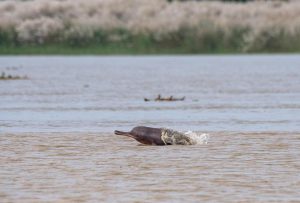Australian scientist Robert May is a professor in the zoology department at Oxford University and former chief scientific adviser to the UK government.
In a paper published in the journal Science last month, May and co-authors claimed to debunk apocalyptic estimates that most species will go extinct before they can be discovered. The earth, they say, has far fewer species than has been widely believed – two to eight million of them. Previous estimates have ranged up to 100 million.
And, with 1.5 million species already named, there’s a good chance we could document most of the rest by the end of the century, say the scientists. May told chinadialogue why this matters.
Olivia Boyd: Is your message that we’ve been too alarmist about species loss?
Robert May: I think we certainly should be worried about the accelerating rate at which we’re losing species. But on the other hand I don’t think we’re being particularly helpful when, given a situation that’s already bad, we tend to reach for the worst number rather than the most likely one.
The paper in question is not saying that everything’s OK. It’s just saying that, of the possible estimates of how many species there might be alive on earth today, which some people have estimated maybe we only know one in 10 or even less, things are probably a good deal better than that. The total number of species might be as many as four or five times the number we already know, or maybe only twice the number we already know.
Moving on, that makes it more likely that we can know them all. And that is made even more likely by the fact that, although it may well be that the number of specialists in finding and naming species – taxonomists and systematists – is slightly decreasing in the developed world, rather cheeringly in the developing world where there weren’t many before, the numbers are increasing. The result is there are probably more in total than there were.
OB: Why does it matter that we understand the number of species out there?
RM: We are on a trajectory of a more and more crowded world in which people are having more and more impact on the environment. And there are serious questions about how we’re going to feed them and maintain the ecosystem services that are not counted in conventional GDP by economists, but are estimated to be roughly equal to global conventional GDP in the services they deliver – freshwater, pollination and the like.
There are threats confronting us and to deal with them we really need to know what is there. As habitats are destroyed, we have to ask what are going to be the consequences for the species that live in them and what will be the knock-on effects for us? We need to have a better understanding of how ecological systems are structured and how they respond to disturbance and how we can manage that. And looking at it at that level, you have to go one deeper to ask what are the species that are there? It’s rather hard to work out how a particular ecosystem functions if you don’t even know half the species in it.
So you could say there are three categories of argument. One of them says that the species that are being crowded out by us and are at risk of extinction, such species could be holding future benefits to us in the genes they contain. I call that the narrowly utilitarian argument. That doesn’t worry me so much as I think we’re going to learn so much as the decades go by about the molecular machinery of life that we’ll be able to make our pharmaceutical products designed from the molecules up, rather than borrowing from nature.
Then there is a more worrying, broadly utilitarian argument that says that ecological systems deliver us a lot of things we count on and we need to take better care of them.
And then, above all of that, there is what might be called a broader ethical argument. That says, with rates of extinction perhaps not as high as the most alarming estimates but nonetheless increasing to rates that we haven’t seen for a long, long time, if that persists, we’re going to be handing on to future generations an impoverished world. And that’s an argument that carries more force in a prosperous community than if you’re trying to feed a family in Sub-Saharan Africa.
OB: How easy is it for us to predict future rates of species loss? How well do we understand the impact of climate change, for example?
RM: One thing that’s certain about climate change is that it is happening and we’re doing it. On the other hand, the details of the rates at which things are happening are uncertain and we’re still on a learning curve because this is a hugely complicated dynamical system. So we’re discovering, for example, that the Arctic ice is melting faster than anyone realised. We’re beginning to understand why, but that’s a good example of one of the worrying things that exposes our lack of understanding of details. And it could well be that there are things we worry about that we needn’t worry about so much.
Climate change has consequences not just for us but for other living things. It’s very well documented the way it’s affecting distribution of plants and some insects to the benefits of some and the loss of others. Again, understanding this properly is part of the larger understanding of what’s there and how they interact so that we can manage things better as we try to move to a more sustainable future.
OB: Presumably there are some habitats that are harder to get data on than others?
RM: There sure are. We know less about the deep oceans and there are some places that are just difficult. This is not some touchy-feely, greeny thing. I have a wonderful slide prepared by the UK Ministry of Defence which shows areas of the world that are under stress – from soil being exhausted or water becoming in shorter supply, a variety of different kinds of stress – and then it shows as sort of starbursts on this map of the world places where there has been recent serious conflict or is now. And there’s quite a strong correlation.
There are quite a few parts of the world very rich in biodiversity which are just hard to operate in by virtue of the stress and strife that is going on there.
OB: Where they do operate, conservationists often focus on single species – campaigns to save the tiger, for instance. Are they getting it right?
RM: I can tell you dreadful statistics. If you look at the academic conservation literature, you will find that two thirds of the papers are about birds and mammals, 20% are about birds and plants and only 10% are about invertebrates. But invertebrates account for the vast majority of species. And furthermore, of that 10% that are invertebrates, two thirds are butterflies, which are sort of honorary birds.
It is changing, but it’s changing slowly and it’s understandable that if you look at the conservation focus, as distinct from the literature, then it’s even worse. WWF’s annual report is all “charismatic megafauna” – that’s the phrase for it.
On the other hand you have to have sympathy for it because the NGOs have to raise money. And it’s much easier for people to resonate with the cuddly panda than with some inconspicuous insect. And indeed there are some insects that people quite understandably think we would be better off without, like mosquitoes.
So there are real problems. Nonetheless, while it’s understandable that the focus for fundraising has to be on the things that have emotional resonance, with the money thus raised the agenda ought to be diversified somewhat.



